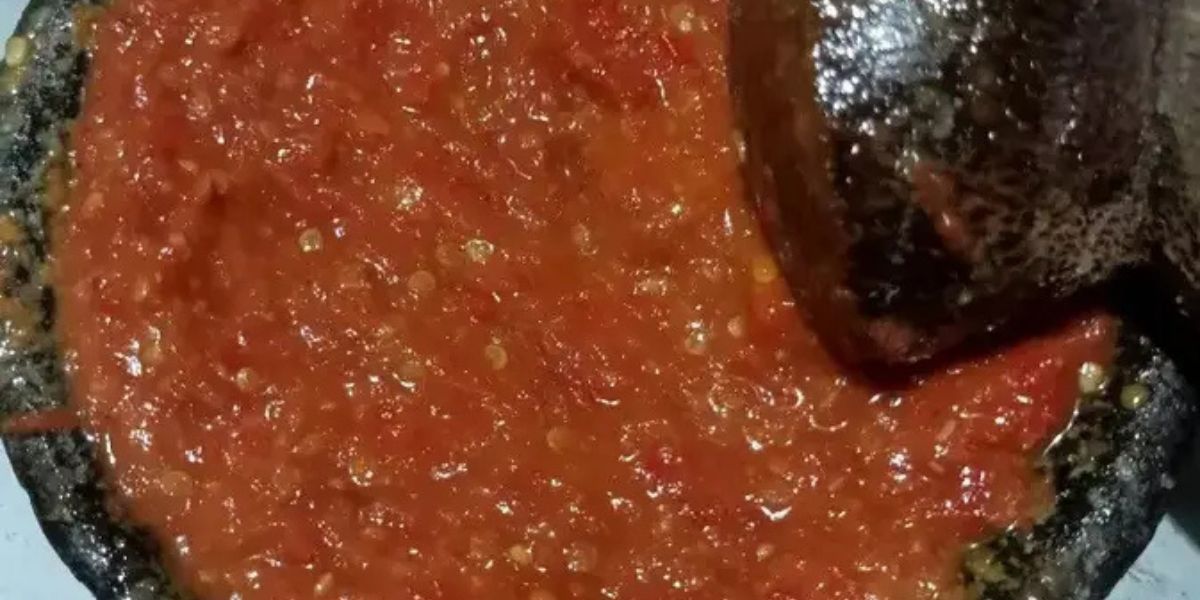5 Delicious Foods That Effectively Lower Uric Acid Levels in the Body!
High levels of uric acid can trigger various serious health problems, ranging from disturbing joint pain to painful kidney stones.

Kapanlagi.com - Who can resist the deliciousness of chili sauce? Almost every Indonesian would agree that chili sauce is a faithful companion in every meal. However, homemade chili sauce often feels less impactful compared to the chili sauce served in restaurants. Many are curious, what is the secret behind the restaurant-style chili sauce that always makes the taste buds dance?
It turns out, there are several simple habits that make the chili sauce in restaurants taste better, from ingredient selection to processing techniques. Summarized by Kapanlagi on Tuesday (25/03/2025) from various sources. In this article, we compile from various sources to discuss five effective habits that restaurants have in creating chili sauce. By following these tips, your homemade chili sauce will taste more delicious, perfectly spicy, aromatic, and surely make you addicted!
Get ready to experiment and create your own version of the tastiest chili sauce! Chili sauce is indeed an essential complement in many Indonesian dishes. Let's explore together the secrets behind the deliciousness of chili sauce that always tantalizes the appetite in restaurants!
Have you ever tasted homemade sambal that seems less punchy compared to the sambal at a food stall? It turns out, there are many factors that influence this difference in taste! The texture, aroma, and flavor of sambal served at food stalls have a uniqueness that is hard to match. One of the key factors lies in the different processing techniques; food stalls often have secret tricks to create sambal that is more appetizing.
In addition, the choice of raw materials also greatly determines the deliciousness of the sambal. Let’s take a look at some simple habits practiced by food stalls to make their sambal more delicious! By applying these tips at home, your homemade sambal can be on par with, or even tastier than, the sambal you usually enjoy at the stall!
One of the secrets to the deliciousness of warung sambal lies in the grinding technique used: the mortar and pestle! Manually grinding sambal not only provides a coarser texture that whets the appetite but also releases the natural oils from the chilies and other spices, creating a richer flavor and enticing aroma. Unlike blenders, which tend to produce smooth and watery sambal, the mortar and pestle ensure that the spices blend perfectly, delivering a complex and authentic taste. So, let’s try grinding sambal ourselves and enjoy the difference!

illustration of red chili/Photo by Elle Hughes on Unsplash
The right choice of chili can be the secret key behind the delicious sambal that tantalizes the taste buds. In warung dining, it is usually combined with red bird's eye chilies known for their sharp spiciness and large red chilies that offer sweetness and an enticing red color. The combination of both creates sambal with a balanced spicy flavor and an appealing appearance. For true spice lovers, don't hesitate to add more bird's eye chilies; however, if you prefer a milder sambal, just add the large red chilies. This way, every spoonful of sambal you enjoy will be an unforgettable experience!
Many eateries now offer a special touch to their sambal by adding grilled shrimp paste and fried shallots, creating a tempting harmony of flavors. Grilled shrimp paste provides a savory nuance and distinctive aroma, while fried shallots add an unmatched sweetness and crunchiness. Just one teaspoon of grilled shrimp paste or one tablespoon of fried shallots per serving of sambal is enough to elevate its taste. For the best results, add both while pounding to ensure the spices are perfectly absorbed, and feel free to experiment with the proportions to suit your taste!
Drizzling sambal with hot oil is a kitchen secret often used in eateries to create an appetizing sambal. This simple technique not only enhances the aroma of the sambal but also eliminates the off-putting taste that can sometimes occur.
By heating 2-3 tablespoons of cooking oil until it’s boiling, you can pour it directly over the pounded sambal, then stir gently until all the spices are perfectly mixed. In addition to highlighting the flavors of the chili and shallots, hot oil also provides a richer texture and helps the sambal last longer. Remember, the key to success is ensuring the oil is really hot so that your sambal becomes even more perfect!
Sambal that has just been made often still feels a bit bland, as the spices within it have not fully blended together. In food stalls, sambal is usually left for a few hours so that the flavors can fully absorb, resulting in a stronger and richer taste. So, if you want the perfect sambal, try to make it a few hours before mealtime. Let the sambal sit at room temperature for maximum flavor. If you want to store it longer, just put it in a closed container and keep it in the fridge, then reheat before serving to enjoy its deliciousness.

Sunda Goang Sambal. (Youtube Kibalox)
Because the grinding process makes the sambal's texture coarser and allows the spices to infuse better. A blender tends to produce sambal that is too smooth and watery.
Yes. Sambal can last up to 3-5 days in the fridge if stored in a closed container. To make it last longer, add a little oil on top of the sambal before storing.
Because food stalls often add grilled shrimp paste, fried onions, and hot oil, which gives a richer and more savory flavor.
Yes! Coconut oil can provide a distinctive traditional aroma, but make sure the oil is really hot to avoid a rancid taste.
Reduce the amount of bird's eye chili and add more large red chili. You can also add more palm sugar or tomatoes to balance the spiciness.
(kpl/khs)
Cobain For You Page (FYP) Yang kamu suka ada di sini,
lihat isinya
High levels of uric acid can trigger various serious health problems, ranging from disturbing joint pain to painful kidney stones.
Discover practical and safe ways to crush ice cubes in plastic without the mess! With this method, you can enjoy neatly shaved ice ready to use without any hassle.
Discover five crucial cooking mistakes that can make your dishes taste flat and unappetizing, and learn smart ways to avoid them. With these practical tips, you'll be able to serve food that is rich in flavor and tantalizing to the palate every time you cook!
Discover the secrets to storing lime leaves to keep them fresh and long-lasting for up to three months with various practical methods that are easy to follow. Enjoy the fresh aroma and distinctive taste of lime leaves in your dishes without worrying about spoilage!
Enjoy the deliciousness of sardines combined with enticing balado spices, perfect for accompanying your iftar moments!
Discover an easy and humane method to quickly kill catfish using salt. This technique is not only effective but also maintains the fish's welfare, making it a smart choice for fish lovers.
Experience the deliciousness of these crispy and savory fried bananas! With a simple recipe that's easy to follow, this dish becomes the perfect choice to accompany your iftar. Prepare a special snack that is sure to delight your taste buds!
Discover the deliciousness of Chicken Lemper in a complete recipe that presents four mouthwatering variations!
Capture the special moments of Lebaran by creating unique and love-filled homemade hampers!
Experience the authentic deliciousness of Coconut Serundeng Chicken with this easy recipe, complete with practical tips to maximize your Indonesian culinary experience!
Learn the effective trick to cook kolang-kaling without slime with easy steps that will surely make it easier for you! Get a chewy and delicious result, ready to perfect your dish.
Explore new techniques for frying thicker and healthier omelettes, without worrying about excess oil! Discover the secrets to making delicious and nutritious omelettes, perfect for starting your day with energy.